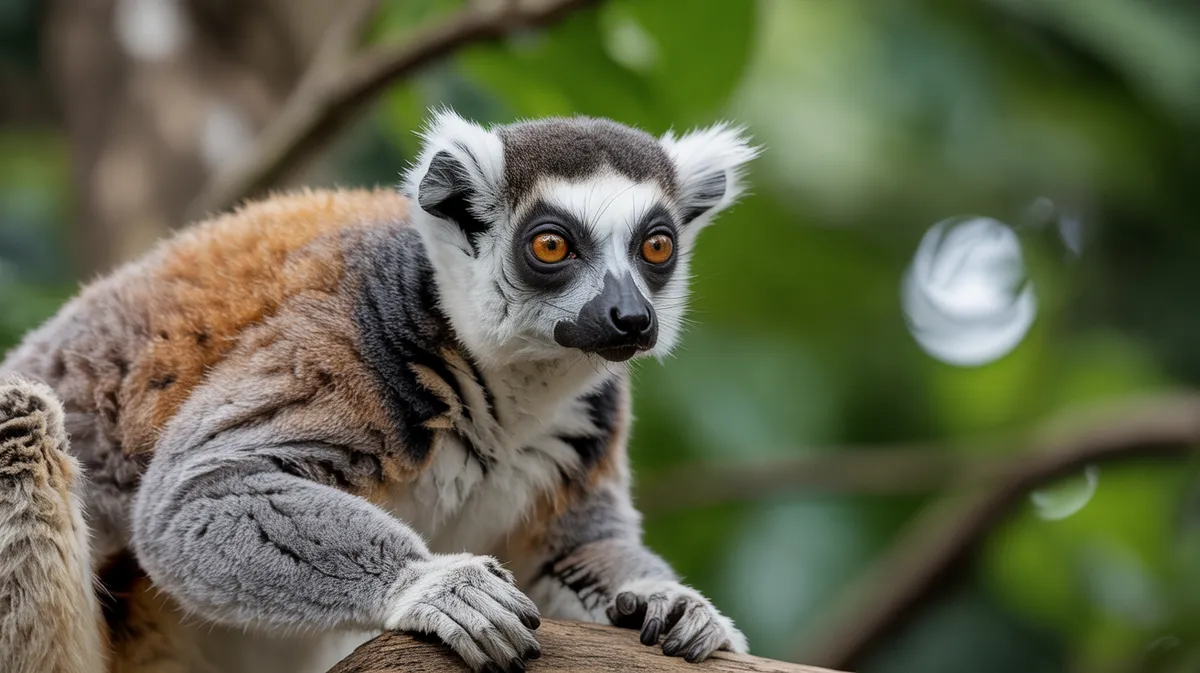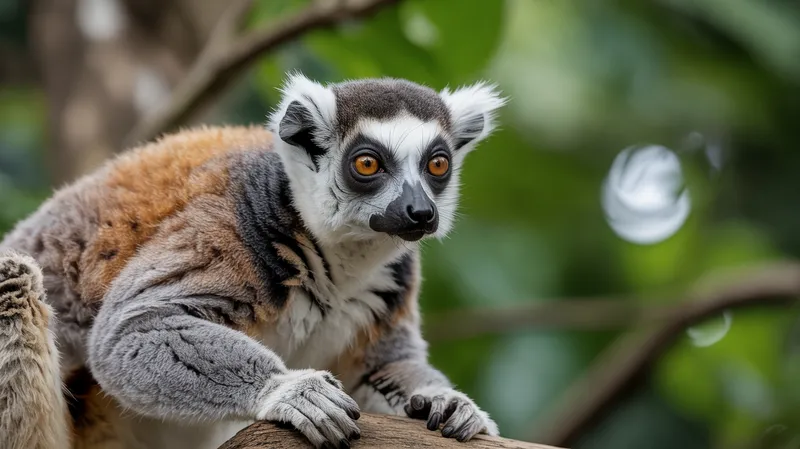
Frilled-necked Lemur
Eulemur macaco flavifrons

Meet the Frilled-necked Lemur
The Frilled-necked Lemur, also known as the Blue-eyed Black Lemur, is a medium-sized primate native to northwestern Madagascar. Distinguished by its striking blue eyes and the frilled fur around its neck, this lemur exhibits sexual dimorphism, with males having black fur and females sporting a reddish-brown coat. It inhabits humid forests, where it is mostly arboreal and agile, moving adeptly through the canopy. This species is social, living in small groups and communicating with a variety of vocalizations and facial expressions. Unfortunately, the Frilled-necked Lemur is critically endangered due to habitat destruction and hunting.
Classification
Mammal
Habitat
Humid lowland and subhumid forests
Diet
Frugivore
Lifespan
15-25 years
Conservation
Critically Endangered
Weight
1.8-1.9 kg
📖Fascinating Facts
Striking Blue Eyes
The Frilled-necked Lemur is one of the only primates in the world with naturally blue eyes, making it instantly recognizable.
Forest Dwellers
These lemurs spend nearly all their lives in the trees, relying on the dense canopies of Madagascar's forests for shelter and food.
Vocal Communicators
Frilled-necked Lemurs use a range of vocalizations and facial expressions to communicate within their social groups.
📋Detailed Description
The Frilled-necked Lemur (Eulemur macaco flavifrons), also known as the Blue-eyed Black Lemur, is a medium-sized strepsirrhine primate endemic to the Sahamalaza Peninsula and adjacent regions in northwestern Madagascar. Adults typically weigh between 1.2 and 1.8 kg, with a head-body length of 39–45 cm and a tail length of 51–65 cm, which aids in balance during arboreal locomotion. The species is sexually dichromatic: males have a glossy black pelage, while females display a rich chestnut or orange-brown coloration, both with a distinctive 'frilled' ruff of fur around the neck. One of its most remarkable features is its vivid blue eyes, a rare trait among primates and unique among wild lemurs. The species is highly arboreal and primarily diurnal, though it may show cathemeral activity (active both day and night) depending on resource availability. Social groups typically consist of 4–11 individuals, often with a female-biased sex ratio and matrilineal dominance. Vocal communication is complex, including alarm calls, contact calls, and affiliative vocalizations, supplemented by olfactory and visual signals. The diet is predominantly frugivorous, but also includes flowers, nectar, leaves, and occasional invertebrates, reflecting seasonal resource fluctuations. The species plays a crucial ecological role as a seed disperser in its native forests. Due to severe habitat fragmentation and hunting, its population is estimated at fewer than 1,000 mature individuals, making it one of the most threatened primates globally.
💡 Did you know?
Despite its captivating blue eyes and unique appearance, the Frilled-necked Lemur was only recognized as a distinct species in the late 20th century.
🔬Research & Sources
🎭Behavior & Social Structure
Frilled-necked Lemurs are highly social, forming cohesive groups with strong female bonds and a clear dominance hierarchy. Group members engage in frequent grooming, which reinforces social ties and reduces tension. They are primarily diurnal but may exhibit cathemeral activity, especially during the dry season or in response to food scarcity. Foraging is a group activity, with individuals moving through the canopy in coordinated fashion, often covering large distances in search of fruiting trees. Feeding bouts are interspersed with periods of rest and social interaction. The species is territorial, using scent marking and vocalizations to communicate group boundaries and deter rivals. Alarm calls are used to warn of aerial or terrestrial predators, while softer grunts and clicks maintain group cohesion. Play behavior is common among juveniles, contributing to motor skill development and social learning.
👶Reproduction & Life Cycle
Breeding in Eulemur macaco flavifrons is seasonal, with mating typically occurring between May and July. Females exhibit a brief estrus period, and mating is often accompanied by increased vocalizations and scent marking. Gestation lasts approximately 120–129 days, with births peaking between September and November, coinciding with the onset of the rainy season and increased food availability. Females usually give birth to a single offspring, though twins are occasionally reported. Infants are initially carried on the mother’s belly and later on her back as they grow. Weaning occurs at around 5–6 months, but juveniles remain dependent on their mothers and the group for protection and social learning for up to a year. Alloparental care, where other group members assist in caring for the young, has been observed, enhancing offspring survival in the challenging environment.
🛡️Adaptations & Survival
The Frilled-necked Lemur exhibits several adaptations for arboreal life, including strong, grasping hands and feet with opposable thumbs and toes, allowing for efficient climbing and leaping. Its long, bushy tail aids in balance during rapid movement through the canopy. The species’ frilled neck fur may play a role in social signaling or in deterring ectoparasites. Blue eyes, while rare among primates, may enhance visual communication or be a byproduct of genetic drift in the isolated population. Their dentition is adapted for a frugivorous diet, with robust incisors and molars for processing a variety of fruits and plant materials. Behavioral flexibility, such as cathemerality and dietary opportunism, allows them to cope with fluctuating food resources in their fragmented habitat.
📚Research Sources
🎨Cultural Significance
While the Frilled-necked Lemur is not widely featured in Malagasy folklore compared to other lemur species, local taboos (fady) in some communities may offer incidental protection. Its striking blue eyes and unique appearance have made it a flagship species for conservation in the Sahamalaza region, raising awareness both locally and internationally. Ecotourism initiatives centered on this lemur have the potential to provide alternative livelihoods and foster community support for habitat protection. However, in some areas, traditional hunting persists, posing a continued risk to the species.
🔬Recent Research & Discoveries
Recent genetic studies have confirmed the distinctiveness of Eulemur macaco flavifrons as a subspecies, with ongoing debate about its status as a separate species. Research using camera traps and radio telemetry has improved understanding of its home range size, habitat use, and activity patterns. Conservation genetics projects are underway to assess genetic diversity and inform captive breeding programs. Studies on vocal communication have revealed a rich repertoire of calls, with potential implications for understanding the evolution of primate sociality. The Sahamalaza-Iles Radama National Park has become a focal point for long-term ecological monitoring and community-based conservation initiatives. Ongoing research is also investigating the impact of habitat fragmentation on seed dispersal and forest regeneration.
🎥Wildlife Videos

Frill-Necked Lizard Escapes Python | Wild Monsoon
About Wild Monsoon: Actor Colin Salmon narrates this program that takes a look at how monsoon winds have shaped the wildlife ...
Nat Geo Animals

The Fascinating World of Madagascar - Where Weird Wildlife Thrives | Full Documentary
Madagascar – the ultimate island. Nowhere else exist so many weird animals at one place. For millions of years, this island lay ...
Free High-Quality Documentaries

UNIQUE AUSSIE ANIMALS: Frilled-Neck Lizard
From the Archives: One of my favourite Lizards, after Crocs of course!
Matt Wright

Wild Australian frilled lizards fight for territory in canopy trees - BBC wildlife
A chance to see rare footage of two wild Australian frilled lizards descending from their tree branch hiding places to fight for ...
BBC Studios

Trouble in Paradise - The Last Lemurs of Madagascar | Free Documentary Nature
Trouble in Paradise - The Last Lemurs of Madagascar | Wildlife Documentary Watch 'Go Ape - The Fascinating World of Primates' ...
Free Documentary - Nature

Saving the World’s Rarest Lemurs | In Her Nature
Greater Bamboo lemurs, recently thought to be extinct, are critically endangered. One Malagasy woman is on a mission to restore ...
Nature on PBS
🌍Habitat Information
The Frilled-necked Lemur typically inhabits Humid lowland and subhumid forests environments. Frilled-necked Lemurs have adapted to their environments with specialized features and behaviors.
Primary Habitat:
Humid lowland and subhumid forests
More detailed habitat information will be available soon.
🛡️Conservation Status
The Frilled-necked Lemur is currently classified as Critically Endangered. Conservation efforts are crucial for preserving this species for future generations.
Common Threats:
- 🏠Habitat loss and fragmentation
- 🌡️Climate change impacts
- 🎯Hunting and poaching
- 🏭Human-wildlife conflict
⚠️Threats & Conservation Challenges
The primary threats to the Frilled-necked Lemur are habitat destruction due to slash-and-burn agriculture (tavy), illegal logging, and charcoal production, which have led to severe fragmentation of its already restricted range. Hunting for bushmeat and capture for the illegal pet trade further exacerbate population declines. The species is highly sensitive to habitat disturbance, with isolated populations facing reduced genetic diversity and increased risk of local extinction. Ongoing habitat loss has resulted in a population decline of over 80% in the past three generations. Conservation challenges include limited enforcement of protected area boundaries, lack of community engagement, and insufficient funding for in situ conservation and research. Climate change poses an additional long-term threat by altering forest structure and fruiting phenology.
🔬Scientific Classification
Scientific Name
Eulemur macaco flavifrons
Classification Hierarchy
🔍 About Taxonomic Classification
Taxonomic classification is a hierarchical system used by scientists to classify and organize living organisms based on shared characteristics and evolutionary relationships.
The system moves from broad categories (Kingdom) to increasingly specific ones, with each animal's scientific name typically consisting of its Genus and species.
📝Community Notes
Share your observations and insights about the Frilled-necked Lemur with our community of wildlife enthusiasts.
Join Our Community
Sign in to share your observations and connect with fellow wildlife enthusiasts.
Sign In to ContributeNo community notes yet
Be the first to share your observations about the Frilled-necked Lemur!
Explore Frilled-necked Lemur
Select a tab above to learn more about this amazing animal.
📸Photo Gallery
No photos available for this animal yet.
🌟Discover More Wildlife
Continue your journey of discovery with more fascinating animals from our database
